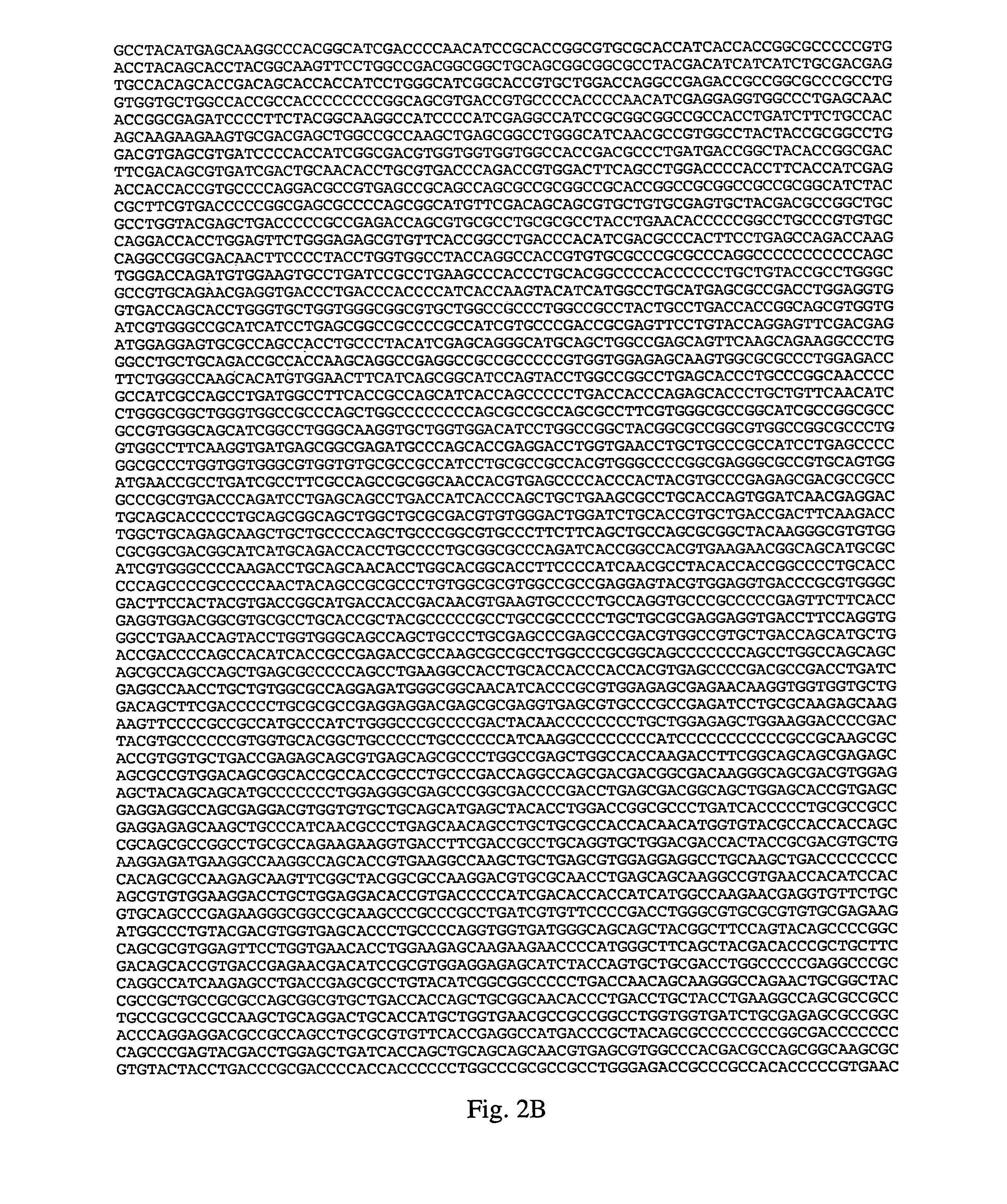Hepatitis C virus nucleic acid vaccine
a technology nucleic acid, which is applied in the field of hepatitis c virus nucleic acid vaccine, can solve the problems of liver failure and cirrhosis, and achieve the effects of reducing the ability of hcv, increasing viral clearance, and reducing the load of hcv
- Summary
- Abstract
- Description
- Claims
- Application Information
AI Technical Summary
Benefits of technology
Problems solved by technology
Method used
Image
Examples
example 1
Annotation of ChAd63 and ChAd3 Genome Sequences
[0177]ChAd63 and ChAd3 were blasted against a local database built with all the protein sequences of the “Human adenovirus C” group (HAdV-C; Taxonomy ID: 129951). Protein sequences were downloaded from the NCBI server by searching for the specific Taxonomy IDs. The blast search was performed using the blastx program. The number of sequences to show in the alignment was set to 1000 and the Filter switched off. Blast results were then analyzed with MSPcrunch, a BLAST enhancement tool for large-scale sequence similarity analysis.
[0178]Every resulting CDS annotation on the two genome sequences was manually confirmed by looking at the position of ATG and STOP codons and when necessary at the position of the splicing sites. All products were searched with blastp into the previously built database of adenoviral proteins to validate the prediction of such products by homology. The plain genome sequences of ChAd63 and ChAd3 were annotated with V...
example 2
ChAd3 Vector Construction
[0181]Construction of ChAd3 ΔE1,E3,E4, E4Ad5orf6 vector involved the following steps:
I. Construction of a Subgroup C Shuttle Vector
[0182]The ChAd3 viral genome was fully sequenced (SEQ ID NO: 14) and the information used to construct a shuttle vector to facilitate cloning by homologous recombination of entire genome. Briefly, the shuttle vector used to clone subgroup C chimp adenovirus 3, referred to herein as pChAd3EGFP, was constructed as follows: a ChAd3 DNA fragment (nt 3542-4105) containing pix coding region was amplified by PCR with the primers of SEQ ID NOs: 20 and 21, digested with SgfI-AscI then cloned into pARSCV32-3 and digested with SgfI-AscI generating pARS-ChAd3D. ChAd3 right end (nt 37320-37441) was amplified by PCR with primers of SEQ ID NOs: 22 and 23, digested with XbaI and BamHI then ligated to pARS-ChAd3D restricted with XbaI and BamHI, generating pARS-ChAd3RD. ChAd3 viral DNA left end (nt 1-460) was amplified by PCR with primers of SEQ I...
example 3
ChAd63 Vector Construction
[0189]A ChAd63 vector analogous to the ChAd3 ΔE1,E3,E4, E4Ad5orf6 vector was constructed as follows
I. Construction of a Subgroup E Shuttle Vector
[0190]The ChAd63 viral genome was fully sequenced and the information used to construct a shuttle vector to facilitate cloning by homologous recombination of entire genome. Briefly, the shuttle vector used to clone subgroup E chimp adenovirus 63, referred to herein as pARSChAd63_EGFP was constructed as described below.
[0191]ChAd63 right end (nt 36216-36643) was amplified by PCR with primers of SEQ ID NOs: 26 and 27, digested with XbaI and BamHI then ligated to pARSChAd3-RLD restricted with XbaI and BamHI, generating pARS-ChAd63R. A ChAd63 DNA fragment (nt 3422-3814) containing pIx coding region was amplified by PCR with the primers of SEQ ID NOs: 28 and 29, digested with SgfI-AscI then cloned into pARS-ChAd63R digested with SgfI-AscI, generating pARS-ChAd63RD. ChAd63 viral DNA left end (nt 1-455) was amplified by P...
PUM
| Property | Measurement | Unit |
|---|---|---|
| length of time | aaaaa | aaaaa |
| nucleic acid sequence | aaaaa | aaaaa |
| size | aaaaa | aaaaa |
Abstract
Description
Claims
Application Information
 Login to View More
Login to View More - R&D
- Intellectual Property
- Life Sciences
- Materials
- Tech Scout
- Unparalleled Data Quality
- Higher Quality Content
- 60% Fewer Hallucinations
Browse by: Latest US Patents, China's latest patents, Technical Efficacy Thesaurus, Application Domain, Technology Topic, Popular Technical Reports.
© 2025 PatSnap. All rights reserved.Legal|Privacy policy|Modern Slavery Act Transparency Statement|Sitemap|About US| Contact US: help@patsnap.com



